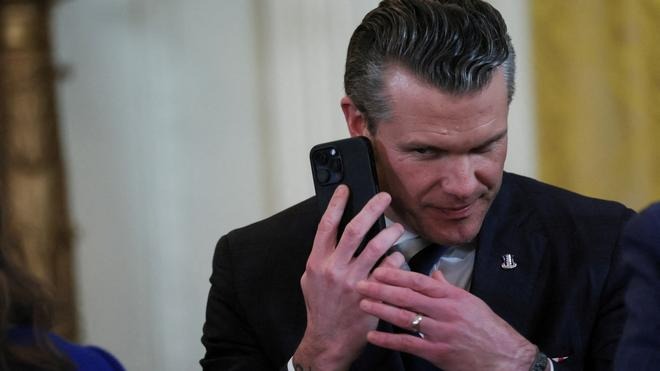In an unprecedented twist that has gripped political and military circles alike, a series of encrypted messages detailing a planned targeted killing operation in Yemen has been thrust into the public spotlight. The leak—originating from a Signal chat and published by The Atlantic—has raised serious questions about national security protocols, the handling of classified information, and the boundaries of government transparency. At the center of this controversy is U.S. Defense Secretary Pete Hegseth, whose texts outlined specific operational details, including precise timings for the planned strike. This article examines every facet of the leak: from its discovery and content to its broader implications for military communications, domestic politics, and U.S. foreign policy in the volatile Middle East.
Table of Contents
- The Genesis of the Leak
- Unpacking the Signal Chat: What Was Revealed?
- Secure Communications in the Digital Age
- Government Response and the Question of Accountability
- Political and Legal Ramifications
- Historical Context: Leaks, Transparency, and National Security
- Expert Opinions: Analyzing the Impact on Military Operations
- International Implications: The Yemen Conflict and Regional Stability
- The Future of Encrypted Communication in Government
- Conclusion: Lessons, Reflections, and the Road Ahead
The Genesis of the Leak
A Shocking Discovery
On a brisk March day in 2025, The Atlantic published a report that sent ripples through corridors of power in Washington, D.C. and beyond. An investigative piece detailed that a Signal chat—an encrypted messaging group originally meant for high-level discussions among top officials—had been leaked to the press. At the center of the leak was a chat conversation involving U.S. Defense Secretary Pete Hegseth, along with other senior officials, in which the planned time for a targeted killing operation against a Yemeni “terrorist” was discussed in real time.
This chat, which included explicit details about the timing and execution of a military strike, was not meant for public consumption. Instead, it was intended to facilitate swift coordination among government officials during an operation aimed at neutralizing a threat deemed by U.S. intelligence as imminent and dangerous. However, due to an inadvertent inclusion of a journalist in the chat, classified details were unwittingly exposed—igniting a fierce debate over operational security, transparency, and accountability.
How the Leak Came to Light
The leak came to the attention of the public in an almost cinematic fashion. Jeffrey Goldberg, the editor-in-chief at The Atlantic, revealed that he had been added to the Signal group chat without the knowledge of its primary participants. The inclusion of a journalist in a private conversation of this nature immediately raised alarm bells, both within government circles and among security experts. In the ensuing days, as the details of the chat were confirmed by multiple sources, the leak quickly evolved from a minor administrative blip to a major national scandal.
Notably, the timing of the leak coincided with ongoing military operations in Yemen—a region already under intense scrutiny due to its complex political and humanitarian crises. This intersection of a sensitive military operation and the public exposure of classified discussions has intensified the controversy, leading many to question the robustness of current communication protocols within the national security apparatus.
Unpacking the Signal Chat: What Was Revealed?
A Glimpse Inside Classified Operations
The leaked Signal chat offers a rare, unfiltered view into the inner workings of high-stakes military planning. According to multiple reports, including those from Reuters and the Associated Press, the chat included time-stamped messages that detailed the scheduling of various components of a targeted killing operation. For instance, one of Hegseth’s messages specified:
“1215et: F-18s LAUNCH (1st strike package)”
“1345: Trigger Based F-18 1st Strike Window Starts (Target Terrorist is @ his Known Location so SHOULD BE ON TIME also, Strike Drones Launch (MQ-9s)”
These messages reveal a level of operational granularity that is rarely disclosed to the public. The detailed breakdown of timing, the specific mention of aircraft (F-18s) and drones (MQ-9s), and the explicit reference to the target’s location, all point to a meticulously planned operation. The text indicates a multi-tiered strike approach—a concept where various platforms work in coordination to achieve a swift and decisive outcome.
Context and Terminology
The term “targeted killing” itself is a subject of considerable debate. Traditionally, the U.S. has used targeted strikes in counterterrorism efforts, particularly when conventional military operations may risk broader civilian harm or prolonged conflict. The language used in the chat—“terrorist”—reflects a specific framing of the enemy that aligns with longstanding U.S. counterterrorism doctrine. However, such terminology is also highly politicized and has historically drawn criticism from various quarters, including human rights advocates and international legal experts.
Beyond the explicit details, the chat’s existence has broader implications. It underscores how modern warfare, increasingly conducted through rapid digital communications, depends on both secure technology and precise human coordination. In this instance, the leak not only exposed sensitive military plans but also highlighted the vulnerabilities inherent in digital communication channels, even those touted for their robust encryption like Signal.
The Significance of Timing and Coordination
The inclusion of specific timestamps in the chat is particularly noteworthy. Military operations rely heavily on precision timing, and the chat’s breakdown of operational windows reveals the complexity of orchestrating simultaneous actions across multiple platforms. The message indicating the launch of F-18s at 1215 Eastern Time and the subsequent window for the strike beginning at 1345 suggests a carefully timed operation that likely took into account factors such as target mobility, enemy countermeasures, and the need for rapid coordination among different military branches.
For those familiar with military protocols, such precision is both a strength and a potential vulnerability. While it demonstrates high operational readiness and the ability to execute coordinated strikes, it also means that any breach in communication—such as the one that resulted in this leak—can have severe ramifications if adversaries gain access to these timelines.
Secure Communications in the Digital Age
The Promise and Perils of Encryption
In today’s digital era, encrypted messaging applications like Signal have become indispensable tools for secure communications. These platforms are designed to protect the content of messages from interception, offering end-to-end encryption that is widely regarded as a gold standard in digital security. For government officials and military personnel, such security is paramount. However, the Hegseth chat leak has sparked a vigorous debate about whether even the most secure platforms can be entirely trusted for transmitting classified information.
On one hand, Signal’s robust encryption protocols provide a significant layer of protection against cyber espionage. On the other hand, the leak highlights a critical issue: human error. Regardless of the technical security of the platform, mistakes such as inadvertently adding an unauthorized participant can undermine even the most advanced systems. In the case at hand, a single misstep allowed a journalist to access and later publish details that could potentially compromise national security operations.
Balancing Accessibility and Security
Modern military and governmental operations rely on the rapid exchange of information. Encrypted apps like Signal are favored not only for their security but also for their user-friendly interfaces that allow swift communication across various teams. However, this incident has exposed the delicate balance between accessibility and security. While ease of use is crucial in time-sensitive operations, it must not come at the cost of rigorous safeguards that prevent accidental disclosures.
This incident serves as a wake-up call, prompting discussions on whether more secure, specialized communication channels should be reserved exclusively for classified military communications. Experts suggest that government agencies might need to invest in proprietary communication systems that, while perhaps less user-friendly, offer additional layers of authentication and monitoring to ensure that sensitive information is never shared inadvertently.
The Human Factor in Cybersecurity
The leak underscores a well-known adage in cybersecurity: the human factor is often the weakest link. No matter how secure a system is engineered, mistakes—whether due to oversight, miscommunication, or technological error—can have devastating consequences. This has led to calls for more rigorous training and stricter protocols for those handling classified communications.
In many ways, the Hegseth incident illustrates the modern reality of digital warfare: operational security is not solely a matter of technological robustness but also of disciplined human practices. The need for comprehensive checks and balances in the digital realm has never been more apparent. As government agencies reassess their communication strategies, this incident could well be the catalyst for a broader overhaul of how sensitive information is handled in the digital age.
Government Response and the Question of Accountability
Swift Denials and Evasive Statements
In the wake of the leak, the U.S. government and military leadership were quick to respond. White House Press Secretary Karoline Leavitt issued statements asserting that no classified information had been compromised, a claim that has met with skepticism among critics and lawmakers alike. Defense Secretary Pete Hegseth, who was at the center of the controversy, refrained from providing a detailed comment on the leaked messages, instead dismissing inquiries as distractions from ongoing military operations.
Such evasive responses have only deepened the sense of mistrust among political opponents and members of the intelligence community. Critics argue that if government officials are unable—or unwilling—to provide transparent answers about the nature and implications of the leak, then accountability may be severely undermined. In an era where public trust in government institutions is already fragile, the incident poses a serious challenge to the administration’s credibility.
The Role of Congressional Oversight
The leak has not only ignited public debate but has also set off alarm bells in Congress. Lawmakers from both sides of the aisle have called for comprehensive investigations into how the breach occurred and whether current protocols for handling classified information are sufficient. The Senate Intelligence Committee, already under pressure to ensure that sensitive operations remain secure, has announced plans to hold hearings that will scrutinize the incident in detail.
During these hearings, key figures in the intelligence and defense communities are expected to testify about the incident, providing insight into both the technical and human factors that led to the leak. Lawmakers are particularly interested in understanding the steps taken to secure communications and what corrective measures will be implemented to prevent similar breaches in the future. As these hearings progress, the incident is likely to become a focal point in broader discussions about government transparency and national security.
Calls for Reform
Beyond the immediate responses, the leak has spurred a broader conversation about the need for systemic reform in how classified information is managed. Critics of current practices argue that reliance on commercial messaging platforms for sensitive operations is anachronistic in an age of advanced cyber threats. There are growing calls for the development and implementation of secure, government-run communication systems that are specifically designed to meet the rigorous demands of military and intelligence operations.
Some experts contend that this incident may well be the tipping point that forces the government to reexamine its reliance on widely used consumer technologies. In the long run, a shift toward more secure, dedicated communication channels could help restore public confidence and ensure that critical operations are shielded from both inadvertent disclosures and deliberate cyber attacks.
Political and Legal Ramifications
Domestic Political Fallout
The revelation of classified operational details in a public forum has had profound political implications. The leak has become a hot-button issue among Democrats and Republicans alike, with critics on both sides questioning the administration’s judgment and operational security. In political debates and media appearances, the incident has been cited as emblematic of broader issues related to executive accountability and the mishandling of classified information.
For some, the leak represents a dangerous lapse in judgment that could compromise not only the success of military operations but also the safety of U.S. personnel on the ground. Lawmakers and security experts have argued that the administration’s failure to maintain the confidentiality of sensitive communications could embolden adversaries and undermine U.S. strategic interests in volatile regions such as Yemen.
Legal Implications and the Question of Criminal Liability
Beyond the realm of politics, the leak raises serious legal questions. If it is determined that classified information was exposed due to negligence, those responsible—including high-ranking officials—could face legal consequences. While no charges have been announced, the incident has already prompted calls for a thorough legal review of the protocols and procedures governing classified communications.
Legal experts are debating whether the leak could constitute a breach of the Espionage Act or other statutes designed to protect national security. Although such cases are rare and complex, the potential for legal repercussions adds another layer of gravity to the incident. In the coming months, as investigations unfold, the legal community will be watching closely to see if this leak sets a precedent for accountability in the handling of classified information.
International Law and the Ethics of Targeted Killings
In addition to domestic legal concerns, the nature of the operation itself—the targeted killing of a designated “terrorist”—raises thorny questions about international law and ethics. While the U.S. government has long justified targeted killings as a necessary tool in the fight against terrorism, critics argue that such operations often exist in a legal gray area. The public disclosure of plans to carry out a targeted killing via an encrypted chat intensifies these debates, forcing policymakers and legal scholars to grapple with questions about sovereignty, the rule of law, and the ethical dimensions of modern warfare.
This leak, therefore, not only exposes internal failings in communication protocols but also brings to the forefront enduring debates about the balance between security and accountability in a democratic society.
Historical Context: Leaks, Transparency, and National Security
A Legacy of Government Leaks
The Hegseth chat incident is not the first time that classified information has been inadvertently or deliberately leaked to the public. Over the past few decades, numerous high-profile leaks have reshaped the national conversation about transparency, accountability, and the limits of government secrecy. From the revelations of the Pentagon Papers to the disclosures by whistleblowers like Edward Snowden, each incident has forced the public to confront difficult questions about how much the government should hide in the name of national security.
In many respects, the current leak fits into this historical continuum. It reflects an era in which digital communications—by their very nature rapid and far-reaching—can inadvertently expose even the most closely guarded secrets. Each successive leak has, over time, eroded some of the barriers between government secrecy and public accountability, prompting calls for reform and a reevaluation of what transparency means in the modern age.
The Impact on Public Trust
Every major leak has the potential to alter the public’s relationship with its government. In the aftermath of the Hegseth incident, public trust in the administration’s ability to manage sensitive information is likely to suffer. Trust is a fragile commodity in a democracy, and revelations of operational missteps or communication failures can have lasting consequences on the public’s perception of government competence and integrity.
By exposing detailed plans for a targeted killing operation, the leak has also raised uncomfortable questions about the balance between national security and individual rights. Critics argue that while some level of secrecy is necessary for effective military operations, unchecked secrecy can lead to abuses of power and a lack of accountability. The public debate following this leak will likely influence future policies on government transparency and the handling of classified information.
Expert Opinions: Analyzing the Impact on Military Operations
Perspectives from Military Analysts
Military experts have weighed in on the leak, with many emphasizing that while operational details are indeed sensitive, the exposure of such information does not necessarily compromise the overall mission. Some analysts suggest that adversaries, already familiar with U.S. military capabilities, may not gain a significant tactical advantage from knowing the timing of a single operation. However, others caution that the cumulative effect of such leaks could erode the element of surprise—a critical factor in modern military strategy.
Analysts have pointed out that precision is paramount in coordinated military strikes. The detailed timelines in the chat, while impressive from a planning perspective, also underscore the risks associated with digital communications. Even minor lapses in operational security can have outsized consequences, especially when adversaries are constantly monitoring open-source intelligence for any hint of U.S. military movements.
Cybersecurity Experts Weigh In
In parallel with military analysis, cybersecurity professionals have offered their insights into the risks posed by using consumer-grade encrypted messaging apps for sensitive communications. The consensus among these experts is clear: while platforms like Signal offer state-of-the-art encryption, they are not immune to human error. The incident illustrates that even the best technological safeguards can be undermined by mistakes in user management or procedural oversight.
Cybersecurity experts argue for the implementation of multi-factor authentication protocols and more rigorous access controls within government messaging systems. They caution that as digital communications become increasingly central to military operations, there is a corresponding need for a cultural shift within government agencies—one that prioritizes digital discipline and the careful management of access rights.
Balancing Transparency with Operational Security
The divergent views among experts underscore a broader tension: the need for transparency in government operations versus the imperative to protect sensitive national security details. Proponents of greater transparency argue that leaks, while sometimes dangerous, are essential for democratic accountability. They contend that the public has a right to know how decisions are made and how military operations are conducted. Conversely, those who prioritize operational security warn that too much transparency can provide adversaries with a roadmap for countering U.S. strategies, thereby endangering lives and undermining national security.
In the wake of the Hegseth chat leak, it is clear that finding the right balance between these competing priorities will be one of the defining challenges for policymakers in the coming years.
International Implications: The Yemen Conflict and Regional Stability
The Complex Landscape of Yemen
The leak comes at a time when Yemen remains a region of significant strategic interest and humanitarian concern. The country has long been embroiled in conflict, with multiple factions vying for control, and a complex interplay of regional powers influencing the dynamics on the ground. For the United States, operations in Yemen have been justified on the grounds of counterterrorism and the need to prevent the spread of extremist ideologies. However, such interventions are often controversial, both domestically and internationally.
By revealing the detailed planning behind a targeted killing operation, the leak not only exposes internal decision-making processes but also brings international scrutiny to U.S. involvement in Yemen. Critics argue that such operations risk exacerbating local tensions and may lead to unintended civilian casualties, further destabilizing an already volatile region.
The Role of U.S. Foreign Policy
U.S. foreign policy in the Middle East has been characterized by a delicate balance between strategic intervention and diplomatic engagement. The decision to carry out targeted killings has often been justified as a necessary means of preempting larger threats, but it also carries significant risks. The public disclosure of operational details through the leaked chat intensifies debates about whether such interventions are conducted with sufficient oversight and accountability.
The incident may prompt international partners and adversaries alike to reassess their strategies when dealing with U.S. military operations. For regional players in the Middle East, the leak might be seen as an indication of internal disarray, potentially emboldening adversaries or prompting new alliances aimed at countering U.S. influence.
Diplomatic Fallout and the International Media
The reaction in international media has been swift and multifaceted. Outlets around the globe are reporting on the leak not only as a domestic scandal but as an event with far-reaching diplomatic implications. Questions are being raised about how transparent the U.S. is in its military operations and whether such transparency undermines its ability to negotiate and cooperate with allies in a complex geopolitical landscape.
International legal experts have also weighed in, cautioning that the incident could complicate efforts to hold parties accountable for potential violations of international law during targeted killing operations. As global scrutiny intensifies, the U.S. government may be forced to engage in a broader dialogue about the ethical and legal dimensions of its counterterrorism strategies.
The Future of Encrypted Communication in Government
Reassessing Technology in National Security
One of the enduring lessons from this incident is the urgent need to reassess how technology is integrated into national security frameworks. While the use of Signal and other encrypted messaging apps has undoubtedly modernized communication within the military and intelligence communities, it also introduces new challenges. The reliance on commercially available software for conducting highly sensitive operations is now under intense scrutiny.
Government agencies may need to consider developing or procuring custom-built communication platforms that offer enhanced security features beyond those available in consumer applications. Such platforms would ideally incorporate stricter user controls, advanced authentication mechanisms, and real-time monitoring to detect and mitigate potential breaches before they occur.
Training and Digital Discipline
In addition to technological solutions, there is a clear need for improved training protocols. The Hegseth incident serves as a stark reminder that even the most secure systems are only as reliable as the people who use them. Agencies must invest in comprehensive digital literacy and security training for all personnel involved in handling classified communications. This includes regular drills, updated security protocols, and a culture that prioritizes caution and accountability in digital interactions.
Innovations on the Horizon
The intersection of national security and digital communications is an evolving landscape. Emerging technologies such as blockchain, advanced biometric authentication, and artificial intelligence-driven anomaly detection hold promise for creating a more secure communication environment. However, the adoption of these technologies will require significant investment and a willingness to overhaul legacy systems that have long been the backbone of U.S. military communications.
As the government grapples with these challenges, the Hegseth chat leak may well serve as a catalyst for long-overdue reforms. By learning from this incident, policymakers can work toward a future where technological advancements are matched by equally robust safeguards and a vigilant, well-trained workforce.
Conclusion: Lessons, Reflections, and the Road Ahead
Reflecting on a Digital Age Dilemma
The leak of the Signal chat featuring Defense Secretary Pete Hegseth’s detailed texts on a planned targeted killing operation in Yemen stands as a stark illustration of the challenges inherent in managing classified information in the digital age. What began as a routine military communication evolved into a public scandal that has exposed vulnerabilities not only in government protocols but also in the very technologies that are supposed to safeguard national security.





